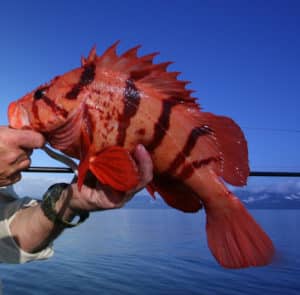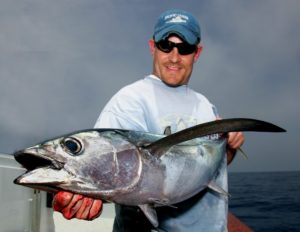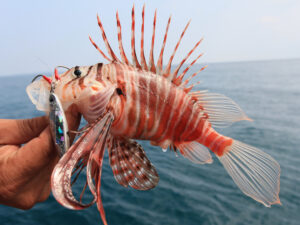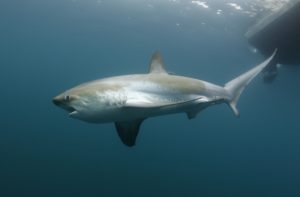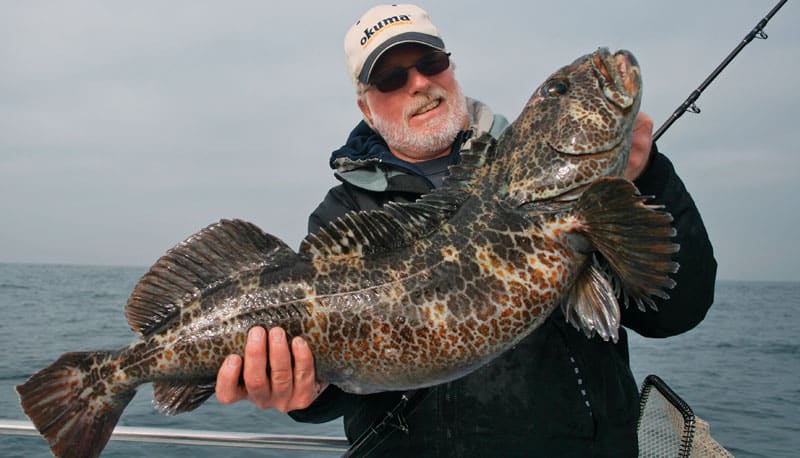
Among Southern California anglers, the lingcod goes by many names. Buffalo cod. Buckethead. Gator bass. Godzilla. Lingasaur. Yet within its realm, the lingcod possesses the heart of a dragon. Intimidating and dominant, it bursts from deep, jagged lairs on winglike pectorals, gobbling prey with fearsome, toothy jaws. When hooked, it uncorks its fiery wrath, pinning anglers to the rail, often destroying lines within seconds.
Southern California lingcod don’t grow as large as in Alaska. But thanks to seasonal closures and restrictive bag and size limits, the population appears healthy in this Pacific region. Daily limits are not unusual, and lings weighing in excess of 25 pounds are fairly common. The California state record is 56 pounds, which was set in 1992.
Yet, like mythical creatures, these lingcod mystify even the experts, appearing suddenly in great numbers, then just as quickly vanishing. While many view lings as solitary, savvy skippers know differently.
“While I don’t consider them schooling fish, lings definitely move around in groups from spot to spot,” says Ryan Carino, skipper of the Southern Cal, a passenger sport-fisher specializing in half-day trips off the coast of San Pedro, Long Beach and Huntington Beach.
Deep Haunts
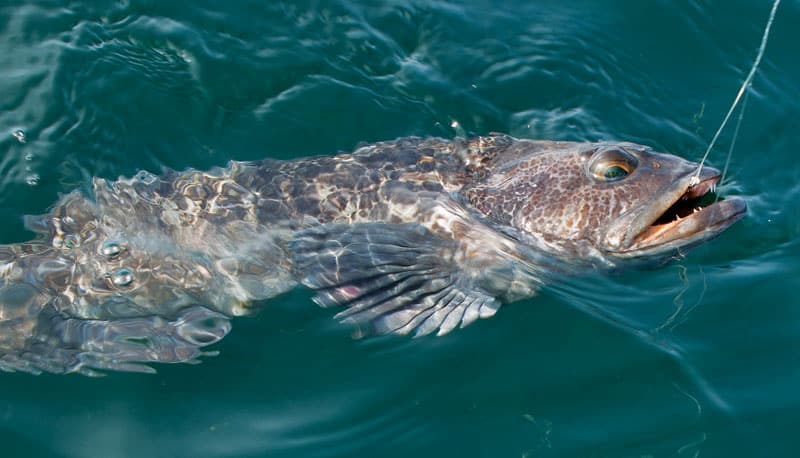
The biggest dragons dine deep, according to Carino. “We find the nicer lings on the outside, on structure spots in 280 to 360 feet,” he says. However, Carino stays adaptable, sometimes finding fish as shallow as 150 feet.
Capt. David Bacon, who specializes in fishing charters to California’s Channel Islands, believes that depth is a relative concept, particularly as you move up the coast. Fishing aboard his Santa Barbara-based WaveWalker charter boat, Bacon’s clients have caught lings up to 40 pounds in much shallower waters.
“The best depths at Santa Cruz and Santa Rosa islands are 180 to 360 feet,” he says. “Yet around the outermost island of San Miguel, we often find lings in less than 100 feet.”
Before you can slay a dragon, you need to find its lair. With lingcod, that means structure — rocks and wrecks. While skippers like Bacon and Carino are loathe to reveal hot spots, both offered guidance to boating anglers.
First step is research. There are a number of books and detailed maps available with coordinates for many structure spots along the coast, as well as around Southern California’s offshore islands.
Second step is fieldwork. Explore with your fish finder and GPS, using the coordinates as reference points. Yet don’t hesitate to expand your search, particularly during California’s lobster season. Some of the prime deepwater lobster spots are also lingcod lairs. Search with sonar around the lobster pot buoys.
Approaching the Lingcod Lair
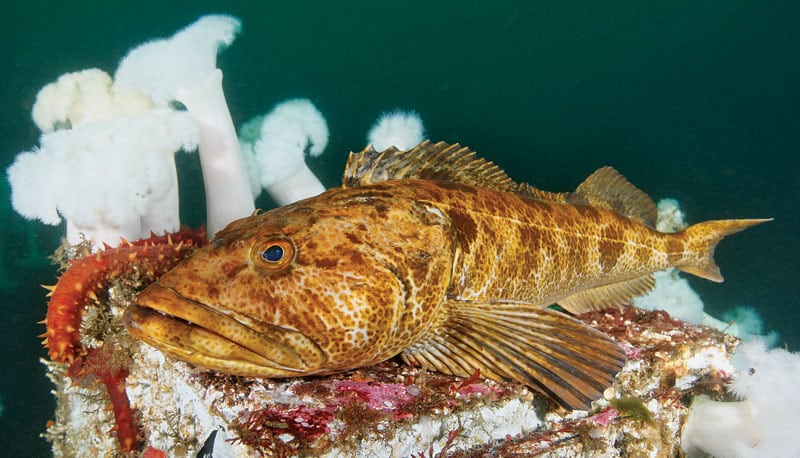
Bacon believes the prime feeding positions on any reef or rocky ledge are along the drop-offs — shadowy caves and cuts where lingcod hide in ambush amid anemones, urchins and gorgonian coral, waiting for current to sweep prey within striking range.
“The big lings will chase smaller lings off the spots,” Bacon explains. “The small and midsize lings then move to the top of the structure, while the big ones live on the sides.” While he might anchor to fish edges, more often Bacon will drift fish. But it takes more than just motoring to the spot and dropping lines to be successful. “I find it productive to use a method I call ‘motor anchoring,’” he says.
With this method, Bacon uses his twin outboards to keep the Grady-White Atlantic 26 positioned directly over the drop-off while others fish. This helps present baits and lures vertically, right in front of the lairs. This is important because big lings sometimes refuse to expend much energy chasing bait.
The technique also minimizes snags but turns into the biggest advantage once you hook a powerful ling, as we will discuss later. The one downside to this technique: His guests — sometimes as many as four — must exercise caution not to tangle lines in the propellers.
When fishing these relatively steep ledges, anglers must ready their baits and lines ahead of time, says Bacon. “I tell my guests to bait up and stand at the rail while I am positioning the boat,” he explains. “Once I say ‘drop,’ they need to free-spool immediately and get to the bottom.”
Carino, on the other hand, fishes a number of local wrecks and prefers to anchor the 65-foot Southern Cal, as drift fishing with as many as 70 passengers often results in a nightmare of tangles and snagged lines.
Positioning the boat depends on the behavioral patterns of lingcod on any given day. “You never know exactly how and where the lings will be feeding until you drop a few lines with different baits,” Carino contends.
Lingcod look for prey such as blacksmith perch, small rockfish, mackerel, sardines, sand dabs, squid and octopuses. However, when a particular type of forage becomes readily available, they adopt feeding patterns best suited to that species, says Carino.
For example, lingcod on isolated wrecks and reefs might leave the structure to forage on the seafloor for sand dabs, a small species of flatfish that becomes abundant at times in the deep waters off Southern California. When lings are in this mode, Carino will anchor to fish the edges of a structure, including the seafloor next to it.
Most of the time, however, Carino anchors the boat to fish the middle of a spot. Anchoring on spots up to 350 feet deep requires a substantial amount of rode — 1,050 feet for 3-to-1 scope — and Carino says anchoring works best for lings when there is just a mild current or breeze keeping the boat tight on the anchor line.
Dragon Traps
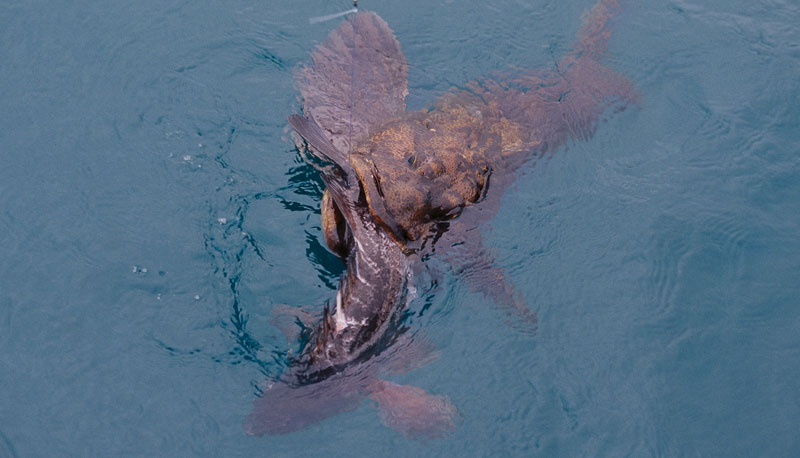
Among the deep reefs of the Channel Islands where Capt. Bacon fishes, small rockfish stay on the menu year-round. This leads to a unique technique. When one of his guest anglers hooks a small rockfish, Bacon likes to let it ride. “Don’t reel it in,” he instructs. “You’ve just got yourself a bigger bait.”
A hungry ling will pounce on a small, struggling rockfish like a dragon on a lamb tied to a stake. Sometimes, however, the rockfish is hooked so deeply that you can’t get the hook into the lingcod. But it doesn’t matter. A tenacious ling might refuse to release a meal, keeping its teeth buried in the rockfish while the angler reels it to the surface and lands it.
A lively Pacific mackerel is another top bait, and many anglers believe the bigger the mackerel, the bigger the lingcod. Yet getting the hook into a ling can be a challenge, so Carino encourages anglers to trap‑rig big mackerel with a single 6/0 to 9/0 hook crosswise through the nose and a 1/0 to 3/0 treble for the trap hook, with just one of the hooks pinned under the skin near the anal fin. “Most of the lings we land this way are hooked by the back treble only,” he reveals.
When fishing the smaller sand dabs, trap hooks are not as critical, but hook placement is often unconventional. Bacon pins a 3/0 to 4/0 hook under its skin along the lateral line in the middle of its dark side. “This keeps the dab horizontal with the white side down and the dark side up, which is natural,” he explains.
Carino doesn’t encourage the use of artificials, but Bacon likes to work heavy jigs and soft plastics for island lings. He has developed his own lure called the LingSlayer, which he kept secret as a charter captain but now sells in his Santa Barbara tackle store, Hook, Line ’n Sinker.
Consisting of a Hopkins spoon mated to a lead-head with a soft-plastic tail, the LingSlayer attracts lings with the flash of the spoon. Bacon believes that the spoon and lead-head clacking together also get a ling’s attention. “It probably irritates him more than anything else, and he eats it just to be rid of it,” he says. “I don’t care why they hit it, as long as it works.”
Reaction Game
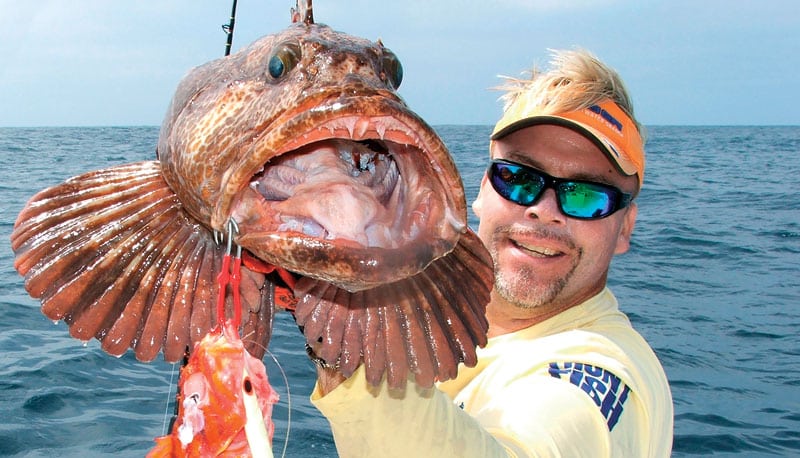
Once bit, you usually win or lose in the first 10 seconds of the fight. Near structure, lingcod have home-field advantage, and the power to drive back into the jagged rocks or wreck. This is also why it is important to fish as vertically as possible. Pulling straight up versus across structure decreases a lingcod’s avenues of escape.
“Apply maximum pressure with a tight drag until the ling is out of the structure, then you can relax and reel the fish up,” says Bacon.
Carino agrees. “Most big fish are lost within the first few feet,” he says. “You either pull the fish away from the bottom, or the fish cuts you off in the structure. After you get him 10 to 15 feet up, then baby the fish. Reel steadily and don’t pull too hard.” Carino has seen many fish lost because the angler pulled too hard once it was out of the structure.
Finesse plays no part in gearing up for lingcod. Both skippers recommend coated braided line ranging from 65- to 80-pound-test. Braid brings to the game abrasion resistance and zero stretch. You feel the bite. The ling can’t stretch you out. And braid stands up well to encrusted rocks and rows of nasty teeth.
Lingcod are not line shy, according to Carino, who sometimes uses a two-foot 40- to 60-pound-test monofilament leader. “I would use a heavier leader,” he says, “but if you snag the bottom, you’d have a tough time breaking it off.”
Bacon, on the other hand, avoids a leader, preferring straight braid. “I want that abrasion resistance all the way to the hook,” he explains.
Both skippers agree on the terminal setup — a hook or trap rig fished on a 10-inch-long dropper loop above 28- to 30-inch leader with a torpedo sinker. The weight of the torpedo sinker depends on water depth, drift rate and current strength, but ranges from 5 to 20 ounces.
Heavy rigs and big fish call for stout rods, such as a CalStar Grafighter 800M, Seeker 270-8H or Penn Bluewater Carnage 800M. “I think these longer rods give you a broader sweep to lift a ling out of the structure, especially when fishing with braided line,” Carino explains.
With thin-diameter lines, the smaller breed of saltwater conventional reels works great for this fishing, but a high-retrieve ratio helps you gather line back quickly when fishing deep. Two-speed lever-drag reels pay off when muscling a big lingcod. Bacon likes the Penn 16VSX two-speed lever drag, but similar reels such as the Accurate BX2-500 or Okuma Makaira 10II work exceptionally well in this quest.
Ultimately, there are no dragons. Yet in the realm of deep reefs and wrecks of the Pacific, lingcod fill this mythical role with ferocious looks, a bad attitude, a voracious appetite and the heart of a dragon. Go slay ’em.

